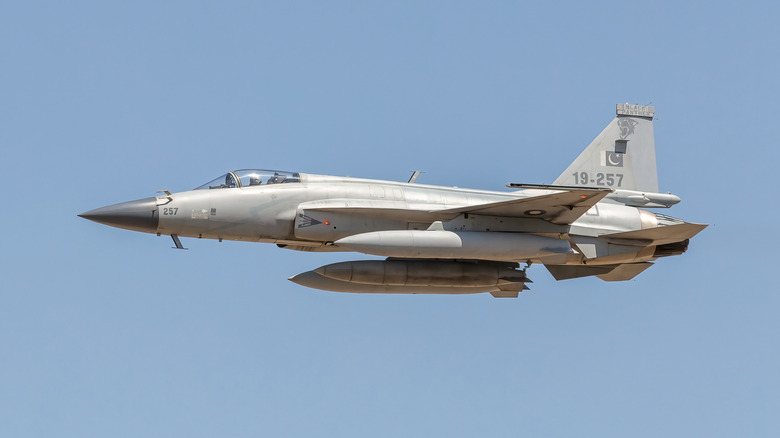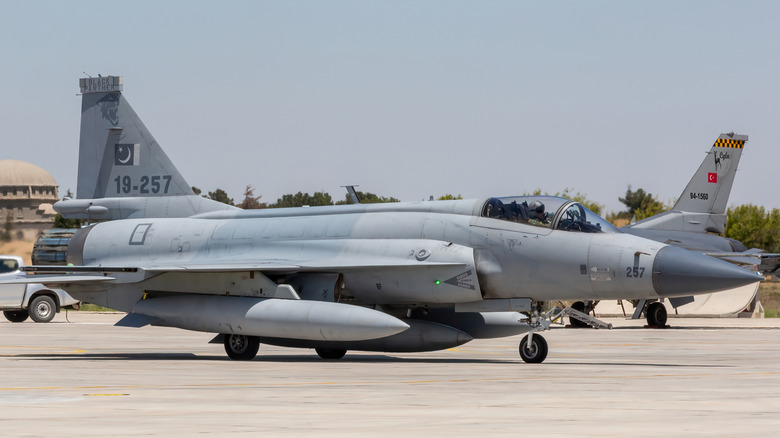What Does The 'JF' In The JF-17 Thunder Fighter Jet Stand For?
The "JF" in JF-17 stands for "Joint Fighter." It reflects the collaborative effort between Pakistan and China to co-develop this multi-role combat aircraft. The jet itself is a product of a partnership between the Pakistan Aeronautical Complex (PAC) and Chengdu Aircraft Corporation (CAC) of China. On the Chinese side, it's known as the FC-1 Xiaolong (Fighter China-1), while "JF-17 Thunder" is the designation used by Pakistan.
The name wasn't chosen at random. It marks a strategic shift. Pakistan had relied on Western aircraft like the F-16, but wanted more autonomy and lower costs. Meanwhile, China needed a modern export-friendly fighter for countries that couldn't afford or weren't allowed to buy American or Russian jets. Together, the two nations aimed to produce an affordable, capable, and customizable fourth-generation fighter.
This collaboration started back in the 1990s, and the first JF-17 flew in 2003. Over time, it has evolved into different variants (Block 1, 2, 3) with upgraded electronics, weapons, and radar systems. So while the "JF" prefix might seem like just a label, it's shorthand for an entire joint program that's reshaped Pakistan's airpower and made waves in global defense markets.
The JF-17 was designed to break dependence
The "Joint Fighter" label isn't just branding. It represents Pakistan's move to break away from dependence on U.S. or Russian platforms. Before the JF-17, Pakistan's air fleet heavily relied on F-16s, making it one of the countries with the most F-16s in their fleets. These came with unwanted oversight (citation) and maintenance challenges.
For Pakistan, the JF-17 meant not just flying a jet but owning the supply chain. The airframe is produced in Kamra, the avionics are tailored by Pakistani engineers, and even the weapon systems (like the Ra'ad-II cruise missile) are integrated in-country. The joint nature of the program gives Pakistan more freedom in terms of software customization and weapons integration.
It also allowed for rapid evolution. The original Block 1 was the first to be developed. Block 2 brought in-flight refueling, and better weapons and avionics systems. Block 3 turned it into a 4.5-gen platform with Active Electronically Scanned Array (AESA) radar, Helmet-mounted display (HMD), improved Man-Machine-Interface (MMI), and WMMC (Weapon Mission Management Computer). Each upgrade came quicker than in traditional programs because Pakistan could make decisions without waiting on foreign OEMs.
That level of autonomy is rare in defense aviation. Even countries with advanced air forces, like the Republic of Korea, often lack control over core tech like radar and EW systems.
A Joint Fighter that's gaining ground internationally
The JF-17 was never just for Pakistan. From the beginning, the joint program aimed to tap into the export market for low-cost, high-capability jets. Many countries can't afford the Rafale twin jet fighter aircrafts or F-35s, and the JF-17 offers a cheaper alternative with real-world combat experience. So far, Nigeria, Myanmar, Iraq, and Azerbaijan have purchased it. Others like Bangladesh, Uzbekistan, and Iran have shown interest.
The jet is tailored for customers. The Stores Management System uses MIL-STD-1760, meaning it can integrate Western, Chinese, or indigenous weapons. Buyers aren't locked into one supplier. The open avionics architecture (coded in C++ instead of military-only languages like Ada) also means upgrades and tweaks are easier to roll out for each country's specific mission.
Combat use matters, too. JF-17s have seen action in anti-terror ops in Pakistan, retaliatory strikes in Iran, and even aerial engagements with India in 2019. Few export fighters at this price point can say that. The jet is also a fixture at global airshows and joint exercises, from Paris to Saudi Arabia to Turkey.
So while the "JF" originally meant a Pakistan-China project, it now signals a growing global footprint. It's not just a joint effort between two countries anymore. It's a platform being jointly shaped by the air forces that fly it.


